Andrea Downing's Blog, page 17
February 26, 2012
MEN, HORSES AND BULLS
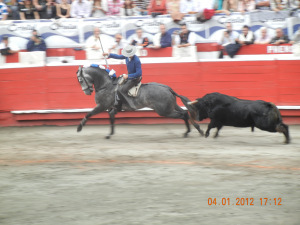
Spanish style costume in Rejoneo
Back in January I had the good fortune to be traveling in Colombia. I found myself up in coffee country at the time of a festival in Manizales and this, to my great interest, included a type of bull fight called a rejoneo. In rejoneo, the matador, now called a rejoneador, is on horseback and it is his skill as a horseman that is the better part of the performance. One of the finest exponents of this sport, Pablo Hermoso de Mendoza, was in Manizales; he travels with a stable of 9 horses, several of which got a chance to strut their stuff in the course of the corrida. While I never learned the breed of horse he employs in these events, they looked very similar to the Lippizaner of the Spanish Riding School , but perhaps more compact and muscular and, indeed, they do very similar haute dressage steps. They danced in place, pirouetted in the face of a charging bull and quick stepped sideways out of the way with a grace that makes quarter horses look plain clumsy (please take a moment to watch Pablo in action here). Four horses are used, each with a different specialty for the four stages of the fight—sort of like switching from your roping horse to your cutting horse. And the rejoneador will have the help in the ring of a toreador on foot to distract the bull when needed.
The entire performance was quite a spectacle. It started with a parade around the ring, the rejoneadors dressed appropriately in eye-catching costume. Hermoso de Mendoza sports the usanza española, a conservative outfit of short jacket, waistcoat, brown leather chaps and broad flat-brimmed hat. One of the other rejoneadors, the older Antonio Ribeiro Telles, wore the more flamboyant Portuguese suit which looks like something out of the 1700s with its long, brightly colored and embroidered jacket, white breeches and tricorn hat.
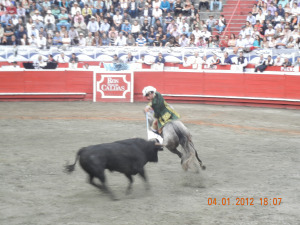
Example of the Portuguese costume
The audience around me was no less ostentatious. While the men were for the most part comfortably dressed for a day in the sun watching sport, the women put on a fashion show of eye-catching jewelry, fancy tops over tight pants (including one young lady wearing a backless leather number) and 6 inch heels. Between each session food and booze was passed around in happy abandon, despite the fact we had just witnessed the bloody slaughter of a bull.
The rejoneo apparently started in Spain and Portugal as training to fight the Moors. After the expulsion of the Moors, their noblemen began lancing bulls for sport although the Spanish eventually stopped the practice. The bulls used nowadays are fairly slight, weighing in at around 1200 lbs. in order to be fleet of foot. They have charming names like Flower and Pickle, but I don’t think that makes them any less deadly. The spectacle is being enhanced in the 21st century by various new fangled ideas. For instance, the rejon de castigo, or punishing lance, which is used to start off the proceedings, reveals a flag when it punctures the bull. One of the rejoneadors, young Willy Rodriguez, had replaced the flag with an ‘explosion’ of sparkles
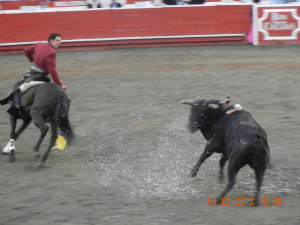
an explosion of sparkles
which delighted the crowd. But, nonetheless, with all of this show I had to ask myself where is the excitement? There’s grace and beauty in the horsemanship, that’s for sure, but watching bulls get methodically slaughtered and hence vomiting blood is not the most pleasant pastime I’ve ever encountered.
Back in New York 6 days later, things were a bit more high tech over at Madison Square Garden where I moseyed on down to catch the last day of the PBR. With flashing bright strobe lights and the initials PBR bursting into flames,
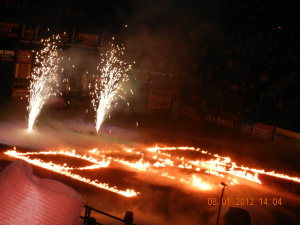
PBR bursts into flames at Madison Square Garden
twenty competitors swaggered out into spotlights. Professional bull riding is billed as America’s toughest sport and it is also the fastest growing. While the common sense of time and humanity has influenced the men to wear protective vests, ‘crashes’ and injuries to the riders are common. Basically the men are wearing traditional cowboy gear: boots, hats, chaps and leather gloves. Occasionally a man will trade his Stetson for a helmet with face guard but other competitors feel this weight unbalances them.
And we’re now dealing with a different kind of bull; these creatures are 1800 lbs and over and specially bred for their overall agility and strength. Their names reflect this: no Pickles or Flowers here. The day I attended, I witnessed Back Bender, Bad Blake and Angry Cactus attempt to murder a few men.

Bull rider at MSG
Sitting inside on comfy cushioned seats rather than the traditional rodeo arena bleachers, we munched American fare of popcorn, hot dogs and soft drinks. I was surrounded by just about every homesick westerner and Brazilian who happened to be in NYC that day—all of us wearing our western gear. It’s sadly true that the only horse around was the one the roper rode; he’s the guy who’s at the ready to throw a noose around the bull if the animal really gets out of hand. And of course there are the bullfighters, commonly called rodeo clowns, who distract the bull so that the competitor can make his way to safety.
Bull riding is a distant cousin of the rejoneo. It purportedly began in Mexico where haciendas would have contests of riding and ranching skills known as charreada. One of the contests devolved from bull fighting had the bulls ridden to death. I don’t think even Ty Murray, ‘King of the Cowboys,’ would be capable of that these days! In any event, this sport went through several permutations—riding the bull until it stopped bucking, then just riding steers, and so on—as it made its way up into Texas and then on to the rodeos of the old west. Eventually, in 1994, the PBR was formed to handle bull riding as a separate entity from rodeo.
So is bull riding exciting? Is it a pleasant pastime? I don’t think “pleasant” is the word to use here, but “exciting,” yes. As long as you don’t move your eyes from the chute you’ll have plenty of excitement watching the most dangerous 8 seconds in sport. This is an activity that requires stamina, strength, and courage—this is NOT about ‘just hanging on.’ But what should one feel about the fact that it is now men getting hurt rather than the bulls? Most of these guys have had so many breaks to their poor bodies they’re virtually bionic. And yet they come back for more—their choice! Poor ol’ Flower and Pickles were led out like lambs to the slaughter, provoked and then killed.
It’s a tough old world out there and it makes me feel we haven’t come far from watching gladiators in the arena.


January 30, 2012
A Visit from Velda Brotherton: Researching Stone Heart’s Woman

Velda Brotherton
I’m very pleased to have as my guest this month the very energetic and multi-talented Velda Brotherton. I first encountered Velda through Women Writing the West and was delighted to subsequently find that Velda and I are both being published by the Cactus line of The Wild Rose Press.
While her forthcoming novel, Stone Heart’s Woman, is a western historical romance, Velda’s multi-faceted career includes both fiction (historical and contemporary) and non-fiction books, writing workshops and speaking engagements. Velda’s extensive knowledge of American history is an obvious starting-point for her historical novels but it is the personal research she does that truly helps bring her books to life. Here she talks about the journey she took and research she did for Stone Heart’s Woman.
Researching Stone Heart’s Woman
The idea for this book came when we drove north out of Oklahoma one fall day headed for Nebraska. It’s my husband who usually thinks of specific places to visit because he’s a consumate reader of both fiction and nonfiction. We stopped first at a former fort, Camp Supply, that is now used as a prison. Men there care for horses, and we were treated to a visit with one of the inmates and some of his horses. We were also allowed to tour the old fort and go in some of the buildings.
This is where I first heard about the Northern Cheyenne and their flight to freedom. As we traveled on north, hubby said let’s go to Ft. Robinson. That’s where they fought their final battle with the soldiers. Of course, he’d read some of the stories about this tragic trail, not made nearly so famous as the Trail of Tears. None of the tales of desperate acts of survival by Indians have been so heart rending at the 1500 mile flight of these people when they fled Indian Territory in 1878 headed back to Yellowstone country and their original home.
It’s a story of epic proportions. The army pursued them, taking lives as they could. But the Cheyenne persisted until they reached Ft. Robinson, where the small remainder of their numbers were locked up. I still didn’t have my book, though. I wanted to write a western historical romance set during this time, but so far, didn’t have much to help me there.
Then I bought a book called Cheyenne Autumn written by Mari Sandoz and in it saw this simple sentence: “Then there was a light-haired boy called Yellow Swallow, the Cheyenne son of General Custer.” That was a first hint at a character. Not this boy, perhaps, but a man, the son of Custer when he was much younger, who would be the right age to take part in this war. But on whose side would he be? He would certainly be pulled in two directions.
Then I was reading an old article written about Dull Knife, the leader known as Morning Star by the Cheyenne, and a quote at the end of the article, mentioned Stone hands joining. And Stone Heart was born. He had a white name, but not one of any consequence. He would be my hero, a man torn between two worlds who would have to make a choice between his father’s people and his mother’s. What a wonderful character he would be, with his golden hair like Custer’s, and his mother’s bronze skin. A boy educated in the white ways, whose father is doing his best to destroy the Indian culture.
But wait. A romance needs a heroine too. I had already written several books having to do with heroes and heroines of mixed blood (Cherokee and Sioux) as I’ve always been fascinated by how such children would handle their ethnicity. My father had Cherokee grandparents on both sides, as well as white ones, so the curiosity is understandable.
In my imagination I finally discovered an Irish girl living with her mother and brothers in St. Louis, who followed her fiancé west into Nebraska when he promised to marry her. He abandoned her in a small town not far from Ft. Robinson and she took to the stage, singing and dancing to entertain men and earn enough money to go home. But the good women, led by the preacher’s wife, decided to run her out of town on a cold January day in 1879, just about the time of the final outreak of the Cheyenne and the ensuing bloody battle around Ft. Robinson. A battle Stone Heart has decided to join to help his mother’s people escape.
After our trip to Ft. Robinson and driving along the trail the Cheyenne walked on that long ago day, I knew this was a story that needed telling. But through the eyes of this white woman and Stone Heart as they struggled to come to terms with what life had handed them. Did Custer have other children with the Cheyenne women? It is said he did. The Cheyenne told of a daughter with yellow hair, so I figured it wasn’t too far a reach to add another son to the mix.
Historical research can carry us into the most adventuresome of worlds. Since I began to write historical romances, I’ve learned to love history for the stories it tells and those it makes possible to tell. How fascinating to create fictional characters and place them in the middle of a factual time and place to see how they’ll react. What unusual things happen when we do something like this. It’s like visiting the past ourselves and living there for the time it takes to write the novel.
I had a long way to go in my research, but I was ready to begin my story. Usually, I do the basic research until an idea springs forth, then I begin to write the first draft, making notes in the margin where I’ll need to do more research. It takes me at least a year to research and write my novels. Stone Heart’s Woman is the seventh published historical romance, all in the western sub-genre. The first six are available on Kindle. I’m working on another one discovered when we took another trip, this time west through Texas. The research is finished, a vague synopsis written. I never outline a book, just write out a few pages of who, what, where, when and how. I can’t wait to begin the draft. No telling where it will lead me.
***********************************************************************
Stone Heart’s Woman is available from The Wild Rose Press in paperback at http://www.tinyurl.com/7shy2sy The ebook will be available Feb. 17th.
Velda’s website is at http://www.veldabrotherton.com/ and her blogs can be read at


January 3, 2012
The Coffee That Won the West
839,972 Pounds Roasted Daily
A few months back I was deeply engrossed in reading a number of cowboy memoirs of the late 19th and early 20th centuries, doing research for the historical western romance I was writing. I was amused to discover the number of everyday products the men mentioned consistently, some of which have now gone from the shelves. There was Sapolio soap powder, Eagle Brand milk (still going strong) and, as any western historian will know, Arbuckles’ for coffee. Ike Blasingame, in his Dakota Cowboy, (University of Nebraska Press, 1958) gives Arbuckles’ more than a passing mention; he describes the chuck wagon and “A flat-sided coffee grinder was bolted to the side of the wagon, handy to reach, for in those days our coffee was made from freshly ground coffee beans. Most all outfits used the famous Arbuckle brand. It came in huge burlap bags holding one hundred one-pound packages of whole beans which were ground in the mill as needed. I remember the stick of candy in each package, as well as a coupon, good for dozens of premiums—handkerchiefs, lace curtains, shears, Torrey razors, and jewelry of all descriptions, including wedding rings.”
Having read about Arbuckles’ so often, I decided to try to discover a little bit more about the “Coffee That Won the West” and see what had become of it.
Right up through the Civil War, coffee was primarily sold ‘green’ and had to be roasted by the consumer. This was done in a skillet over the campfire on the range or in a wood burning stove at home, and it had to be done in small batches: while green coffee beans could be stored indefinitely, roasted beans were subject to oxidation, leaving the beans rancid within a couple of weeks. Furthermore, such individual roasting made for inconsistency, and one burnt bean could ruin an entire batch. Beans sold by grocers pre-roasted were subject to not only this inconsistency but also to mixed quality and to the vagaries of the grocers’ scales.
The family grocery business of Arbuckles’ was established in Pittsburgh in 1859. John Arbuckle dropped out of college to join the firm, which included his brother Charles, in 1865, and his first innovation was to pack roasted coffee beans in 1-lb. packages, ready for the customer. In 1871 the Arbuckles Bros. Co. was formed and moved to New York. John Arbuckle then went on to invent an egg and sugar glaze that “closes the pores of the coffee, and thereby all the original strength and aroma are retained.” (from the back of an Arbuckles’ trade card, circa 1890s). Packed in l lb. packages, the coffee was an instant hit and Arbuckles’ Ariosa Coffee was born. By the 1880s, Arbuckles’ was the largest coffee importer in the world.
Part of their success was due to their marketing innovations. The bags of coffee were packed in sturdy crates, which eventually found their use in grocery store shelving and other impromptu uses such as repairing homes for the Navajo in AZ. Now collectible, one crate that survived intact recently sold at auction for $300. The bags themselves had an attractive, bright red and yellow label and contained a peppermint stick; this proved to be a means by which Cookie could bribe cowboys to grind the beans. Arbuckles’ was also the first, in 1873, to advertise coffee on a full color handbill. And best promotions of all were the coupons, as Ike Blasingame mentions above, along with trade cards. The trade cards were works of art in themselves, and the different series included all the US states, countries of the world, humorous sketches, patriotic scenes, and maps.
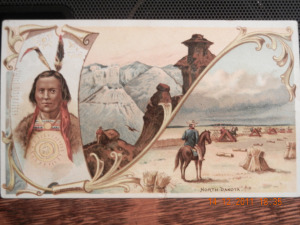
Card No. 28, North Dakota
The reverse side could be anything from an ordinary postcard backing to advertising slogans, recipes or a picture of the factory as above. Now collectors’ items, they are often available on eBay, and a cookbook of the recipes has also been released.
While the Arbuckle Bros. diversified into other areas of commerce, including sugar refining, and owned a ranch in WY as well, it was as coffee magnates that they were primarily known. When 20th Century improvements in packaging made the glazing of beans unnecessary, the company continued to blend premium coffees. John Arbuckle developed a ‘Yuletide’ blend that was eventually marketed as Yuban, now owned by Kraft Foods. Sometime after John Arbuckle’s passing in 1912, the company was sold on to C.W. Post of cereal fame, eventually becoming part of General Foods.
But the Arbuckles’ story doesn’t end there. In 1974, Pat and Denney Willis decided to start a company in order to provide their restaurants with coffee of a consistently good quality. They took on a salesman named Ken Arbuckle who claimed to be descended from the Arbuckle Brothers—and so Arbuckles’ Ariosa Coffee was resurrected. Now located in Tucson, it still comes with a peppermint stick inside the bright red and yellow 1 lb. packages, and cowboys today can still say ‘they ain’t worth shootin’ ‘til they’ve had their Arbuckles’.
***********************************************************************
My sincere thanks to Denney Willis for help with the information contained in this article and, most especially, for agreeing to donate a bag of Arbuckles’ to one lucky person who leaves a comment below, to be randomly selected by him on Jan. 20th. For those of you not lucky enough to win but who would like to try The Coffee That Won the West, you can go to the Arbuckles’ website here and brew up!
I’m pleased to announce the winner of the 1 lb. bag of Arbuckles’ is Sue Cauhape. Congratulations Sue, and thanks to everyone who left a comment.
******************************************************************
I’m further indebted to the University of Nebraska Press for their kind permission to use the above passage from Ike Blasingame’s Dakota Cowboy,1958. Blasingame was the rough string rider, or bronc twister, for the British-owned Matador Cattle Co. when it moved from Texas to the Dakotas. He describes his 8 years with them, from 1904-1912, in highly literate and perceptive language. It’s a book anyone interested in the history of the Old West should read. Available here.


November 27, 2011
Moreton Frewen / Mortal Ruin

Courtesy of Moreton Frewen Collection, American Heritage Center, University of Wyoming
I first learned of Moreton Frewen when reading Elisabeth Kehoe’s book, Fortune’s Daughters: the Extravagant Lives of the Jerome Sisters (Grove Atlantic, Ltd., 2004). Frewen, born 1853, a younger son of a wealthy and well-connected Sussex squire,
was not originally considered suitable for oldest of the Jerome sisters, Clara, who had been brought up in Paris, virtually in the Court of Louis Napoleon. He could not expect much of an inheritance as the extensive properties held by the squire were entailed under primogeniture. Moreton, as a gentleman by birth, would normally be expected to enter the clergy, the Services or politics.
But fate took a hand. In 1878 Frewen went to Texas with John George Adair, a wealthy Irishman who had half-interest in Charles Goodnight’s JA ranch in the Llano Estacado. Frewen, an adventurer by nature,
became enthralled by the idea of the West’s cattle industry.. Back in England, he squandered the remains of his £16,000 (approx.$80,000) inheritance and returned to America with his brother Dick and into the arms of Clara Jerome.
The Jerome family was wealthy enough and certainly snobbish enough to originally turn up their noses at the younger son of the Duke of Marlborough as a suitor for their middle daughter, Jennie (who would be mother to Winston Churchill), so when, in 1879, the penniless Moreton Frewen began to make his suit, he was hardly in the running. Moreton went on to Wyoming with Dick and four friends, first for hunting and subsequently to seek out the land to establish Frewen Bros. Cattle Co. By late December the Frewens were on their own searching for range in an inhospitable climate. After helping a band of Shoshoni kill enough buffalo for winter food, the brothers decided to use the herd as snowplows, stampeding them through a mountain pass to flatten the snow drifts so that they themselves could get through. The range they eventually discovered and settled was a swathe of the Powder River Basin extending eighty miles north and south and fifty east to west; their headquarters were more than 200 difficult miles from Rock Creek station on the Union Pacific.
The ranch house that Moreton built avoided the mosquitoes and took advantage of an outcrop of coal for fuel. Purportedly the first two story residence in Wyoming, it had a solid walnut staircase and woodwork imported from England, papered walls and a ‘minstrel’s gallery’ so that musicians could entertain guests in the dining room, which could seat 20 comfortably, or in the main room which was 40 ft. square. Materials for a telephone line were brought in and this ran 20 miles from the headquarters to the Frewen Bros. store at Powder River Crossing. A piano was imported from Chicago along with chintz hangings and chair coverings; a library was well-stocked. There were, of course, living quarters for servants. It cost Frewen around $900 a month to run and was named Big Horn Ranche (sic); the cowboys called it ‘Castle Frewen.’
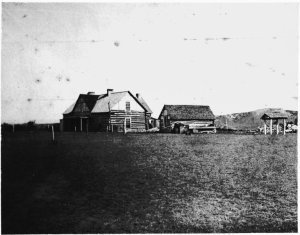
Courtesy of Moreton Frewen Collection, American Heritage Center, University of Wyoming
And it was all built on borrowed money.
The herd was started with 4500 head bought from the ‘76’ brand; it would eventually increase to ten times that amount with 9000 sheep and some 700 horses. Sadly for Frewen, the number of herds on the Powder River would also increase. While the first round-up in Wyoming in 1874 required only 2 divisions, in 1884 there were no less than 31 divisions and the round-up system became law in the Territory. In one division alone 200 cowboys with 2,000 horses worked 400,000 cattle over a 6 week period, with Reps visiting other divisions to get any cattle that may have strayed; 3 ropers succeeded branding 166 cows in 80 minutes!
Moreton, of course, won Clara eventually and the couple were married in high society’s Grace Church in NY, June, 1881. Clara made the arduous journey out to the ranch where the Frewens had a long list of lords and ladies who came for opulent hunting parties, scouted by ‘Buffalo Bill’ Cody, in the autumn. But when Clara joined one group and became ill, thereby suffering a miscarriage, she returned to New York never to set foot in Wyoming again.
By August, 1882, Moreton had bought out his brother and formed the Powder River Cattle Company with himself as unpaid manager, taking shares for the value of the ranch.
From a 24% dividend one year, by 1885 the company was in deep trouble. Two bad winters had brought losses, and rustlers, raiding Indians, wolves, grasshoppers and prairie fires had taken their toll, greatly exacerbated by overcrowded ranges. These were being reduced by a growing number of homesteaders; ranchers had a policy of filing only for land for water rights or their own homesteads or line camps, often counting on employees to file sections and re-sell in due course. The open range between these filings was now heavily encroached upon, leaving too little grass for far too many cattle.
Moreton Frewen had innovative ideas for increasing the company’s income by shipping cattle directly to England, bypassing the Chicago meat-packing consortium (much of the thrust for anti-trust laws in the U.S. came from wanting to break their monopoly). But every venture took money he had to borrow and the creditors began knocking at his door while the Powder River Company was losing money as well, partially due to his mismanagement. At a time when ocean crossings took 12 days, Moreton was rarely at the ranch (he claimed to have made 100 crossings in his lifetime). Finally, in 1885, he was dismissed from his position, his own shares worthless. The most horrific winter of ’86-’87 with cattle losses between 50-75% put an end to the era of the large cattle companies; the final nail in the coffin of the Open Range was Wyoming’s Johnson County ‘War’ in 1892.
While Moreton Frewen had many ideas for money making and investing on a large scale, none came to fruition. Frewen and his wife simply could not live in any style less than that to which they were accustomed. Even when the bailiffs were in their house, Clara, who had never lived with less than 7 servants, paid one of the bailiffs 10 shillings to polish mirrors and answer the door! Yet Frewen was also a man before his time. He foresaw the Panama Canal 35 years before its completion and the St. Lawrence Seaway some 74 years in advance. He was a friend to every President from Hayes to Wilson. And he was daring to the point of foolhardy: once when his horse went lame on the way to Rock Creek, he made the last 40 miles on foot, a journey of 26 hours through snowdrifts and mountains. He also removed a bullet from his own leg, riding 50 miles into Calgary in heavy snow. And of course he was virtually the first settler on the Powder River when the only white men who lived there were hunters and skinners. Called “hopelessly visionary” by his father-in-law, the nickname given to him by his brother Stephen’s regiment was “Mortal Ruin.”
Moreton Frewen died, aged 71, in England in 1924 with an estate estimated under £50.
My thanks to John R. Waggener, Associate Archivist and the staff of the American Heritage Center, University of Wyoming, Laramie.
Further reading:
Andrews, Allen, The Splendid Pauper, J.B. Lippincott Company, 1968;
Woods, L. Milton, Moreton Frewen’s Western Adventures, American Heritage Center, University of Wyoming, 1986;
Woods, Lawrence M., British Gentleman in the Wild West, The Free Press, 1989


November 3, 2011
Gunslingers, Poets and Millionaires: 1880s Leadville
This month I have a guest on my blog, Ann Parker, award-winning author
of the Silver Rush historical mysteries. The fourth book in the series, Mercury’s Rise, has just been published by Poisoned Pen Press.
A few months ago Ann and I sat down to lunch in NYC where she held me spellbound with tales of the Great and Good–or the Not So Good–who passed through Leadville, Colorado, center of America’s silver mining industry back in the 1800s. I’m sure you’ll be equally fascinated with what she has to say.
Thank you, Andrea! As we know, Leadville is a long way from New York City, but the two places have some interesting connections. Back in the Silver Rush heyday from late 1879 through the 1880s, many folks came to Leadville for one reason or another, and many from the East Coast. Among them, are some names familiar even to this day.
For instance, the Guggenheims. Did you know that their fortune was founded in Leadville? From his then-home in Philadelphia, Meyer Guggenheim lent a helping hand in 1880 to an old friend, who had gone West many years earlier to make his fortune. To that end, Guggenheim bought a one-third interest in two Leadville mines: the A.Y. and the Minnie. The mines had been barely “holding their own” in terms of shipping enough ore to pay expenses. Soon after Guggenheim joined in, he took a quick trip to Leadville to examine the properties, and hired mining experts to see what they could do to increase the yield. The amount of ore removed from the mines increased to 50 tons a day, but it wasn’t until a fateful day in August that Dame Fortune smiled. Back once again in Philadelphia, Meyer Guggenheim received a telegram from his Leadville associate that stated: RICH STRIKE. FIFTEEN OUNCES SILVER. SIXTY PERCENT LEAD. For 50 tons of ore removed daily, this translates to $1,000 a day in silver alone! (In today’s dollars that $1,000 equates to $22,000. See http://www.measuringworth.com/uscompa...) As noted in the book The Guggenheims: A Family History, “The A.Y. and the Minnie would be the bedrock of the Guggenheim fortunes.”
Others came to Leadville, passing through or even staying for a while. For instance, Susan B. Anthony arrived in September 1877, stumping for women’s suffrage. She spoke to the miners in one of the saloons, at the time the largest buildings around and the only accomodations for public speakers. Alas, the Colorado Legislature voted down the bill in October 1877, even though the governor of the state stood by Miss Anthony in Leadville and spoke up in favor of suffrage.
The James brothers—Frank and Jesse both—wandered through town and even staked a claim, although it appears they didn’t hang around for long. Leadville’s Carbonate Weekly Chronicle, September 4, 1880, noted, “It is currently reported that the notorious James brothers are now and have been for some weeks ostensibly engaged in working a mining claim in the near vicinity of Leadville.”
Doc Holliday came through a number of times in the early 1880s. He even settled for a while in 1883–84 and dealt faro in the Monarch Saloon (located not far from the fictional Silver Queen Saloon of my series), and ended up shooting and killing a Constable Kelly. Others of Holliday’s acquaintance that chanced through Leadville at various times included Bat Masterson (a personage I gleefully used in Silver Lies) and Wyatt Earp.
Gunslingers aside, famous visitors to “Cloud City” included politicians and poets, pundits, and entertainers. Former President Ulysses S. Grant came through on a five-day visit in July 1880 (a visit which plays a prominent role in both Iron Ties and Leaden Skies), and writer/poet Oscar Wilde gave a lecture at Leadville’s Tabor Opera House in 1882. Wilde’s visit was well covered in the news of the day. The Leadville Herald Democrat ran an article titled alliteratively “OSCAR DEAR—Wilde Wrestles Wildly With the Art Decorative in this Mountain Wilderness.”
Later, in Wilde’s book Impressions of America, he said the following about his trip to Leadville:
“. . . I was told that if I went there they would be sure to shoot me or my travelling manager. I wrote and told them that nothing that they could do to my travelling manager would intimidate me. They are miners—men working in metals, so I lectured to them on the Ethics of Art. I read them passages from the autobiography of Benvenuto Cellini and they seemed much delighted. I was reproved by my hearers for not having brought him with me. I explained that he had been dead for some little time which elicited the enquiry, “Who shot him?” They afterwards took me to a dancing saloon where I saw the only rational method of art criticism I have ever come across. Over the piano was printed a notice:—
Please do not Shoot the PIANIST
He is doing His Best
The mortality among pianists in that place is marvelous. Then they asked me to supper, and having accepted, I had to descend a mine in a rickety bucket in which it was impossible to be graceful. Having got into the heart of the mountain I had supper, the first course being whisky, the second whisky and the third whisky….”
This is just a sample of some of the “rich and/or famous” who once strolled along Leadville’s boardwalks. If you are lucky enough to go there someday, you can walk on the boards yourself, listen to echoes of long ago, and perhaps glimpse a ghost or two while you take in views of mountain scenery that haven’t changed much these past 150 years. As Walt Whitman said of a day’s journey from Denver to Leadville and back through Platte Canyon:
“Talk as you like, a typical Rocky Mountain canon, or a limitless sea-like stretch of the great Kansas or Colorado plains, under favoring circumstances, tallies, perhaps expresses, certainly awakes, those grandest and subtlest element-emotions in the human soul, that all the marble temples and sculptures from Phidias to Thorwaldsen—all paintings, poems, reminiscences, or even music, probably never can.”
————–
Ann’s award-winning books, including her latest, Mercury’s Rise, can be found at independent bookstores (http://www.indiebound.org/book/978159...), Barnes and Noble (http://www.barnesandnoble.com/w/mercu...), amazon (http://www.amazon.com/Mercurys-Rise-A...), and other venues.
independent bookstores (http://www.indiebound.org/book/978159...), Barnes and Noble (http://www.barnesandnoble.com/w/mercu...), amazon (http://www.amazon.com/Mercurys-Rise-A...), and other venues.
Leave a comment on this post to be eligible to win a Silver Rush mystery prize! Winner will be announced later this week. To see the rest of Ann’s blog tour, check out her Appearances page on her website (http://www.annparker.net/app.htm).
The winner of Ann’s Silver Rush Mystery Prize is Kilian Metcalfe. Thanks to everyone who left a comment!






